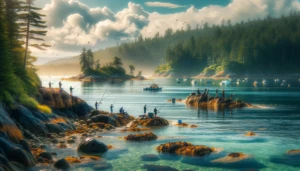Fishing the Kootenay Rockies
Fishing Guides: Kootenay Rockies
Crowsnest Highway: The West Kootenays
It’s hard to escape fish in this area of the West Kootenays. It seems that wherever there’s water – whether lake, creek, or river – there is fishing. At Christina Lake, for starters, fishing for kokanee, rainbow trout, smallmouth bass, burbot, and whitefish is popular, and there are marinas and a public boat ramp in the vicinity.
Anglers frequently have good luck catching rainbow and cutthroat trout in Nancy Greene Lake at Nancy Greene Provincial Park, and ice fishing during the winter season is allowed. The chain of three small lakes that make up the Champion Lakes in Champion Lakes Provincial Park has been regularly stocked with rainbow trout since the 1930s and makes for very good fishing. Development is concentrated around the third lake, which has deep, clear water and a regular shoreline. The others remain in their natural states. The third and second lakes have trout up to 10 inches (25 cm) in length, which will rise to the fly or trolling spoon, and to the persistent angler the first lake will yield fish up to 12 inches (30 cm) in length. Ice fishing is permitted in winter.
To the northwest, the Arrow Lakes, reached via Castlegar, form a dammed lake system 250 miles (400 km) long. Arrow Lake is a part of the Columbia River that was widened and deepened with the construction of the Hugh Keenleyside Dam at Castlegar. Angling for kokanee, Dolly Varden and rainbow trout is popular. Lower Arrow Lake can provide excellent fishing for rainbow or bull trout, and kokanee salmon.
Access to the grand Columbia River is from Highway 22 between Castlegar and Trail. Boat rentals and fishing information on lingcod, char, and trout pike can be had from marinas beside Syringa Provincial Park, which has boat-launching ramps for high and low water.
Kokanee Creek and Kootenay Lake maintain considerable populations of various fish species, including kokanee, rainbow and cutthroat trout, dolly varden, burbot, and whitefish. Kootenay Lake supports record-sized rainbow trout. ‘Kokanee’ means ‘red fish’ in the Kootenay First Nation language and is the name given to the land-locked salmon that spawn in large numbers in Kokanee Creek in the late summer. Rainbow trout are plentiful in Lockhart Creek on the east side of the south arm of Kootenay Lake.
Many of the more than 30 lakes in Kokanee Glacier Provincial Park have been stocked with cutthroat trout. The streams also have rainbow and cutthroat trout and dolly varden. Anglers can do very well for themselves in this park, with good-sized cutthroat trout readily rising to the lure. Fishing is popular at Gibson, Kokanee, Kaslo and Tanal Lakes. For information on angling in Kokanee Glacier Provincial Park, contact the marina at the entrance to the park on Hwy 3A. Boat rentals are also available here. For information about permits required for fishing in the West Kootenays, contact a Fish and Wildlife conservation officer at Castlegar, Nelson or Creston.
Slocan Valley and Upper Arrow Lake
With so much water in this part of the West Kootenays, the fish are never far away. Fishing for kokanee, dolly varden, and bull and rainbow trout is good in Upper Arrow Lake, accessible from McDonald Creek Provincial Park. The various sites comprising Arrow Lakes Provincial Park also provide access to Upper and Lower Arrow Lakes.
There is a small lakeside recreation campsite at Box Lake, 6 miles (10 km) south of Nakusp on Hwy 6, where fly fishing for rainbow trout is popular. The site has a boat launch, but boats are restricted to electric motors only. Farther south, try your luck for rainbow trout or dolly varden in Wilson Creek, at Rosebery Provincial Park. Wilson Creek is closed to fishing below Burkitt Creek. For information about fishing licences, contact the Fish and Wildlife office in Nelson or Nakusp.
North Kootenay Lake and Selkirk Valleys
In what must be one of the classic fisheries blunders, early this century fisheries officers at Gerrard erected a fence and trapping facility facing upstream to capture eggs from the mammoth Lardeau River rainbow trout, hoping to introduce these fish to other river and lake systems. Assuming that the fish dropped down from Trout Lake, they were dismayed to find fish accumulating on the downstream side of the fence in the spring of 1914. The fish were from Kootenay Lake.
Realizing their mistake, they developed an elaborate technique to catch the fish. Eggs were reared at Gerrard, Nelson, Kaslo, Lardeau, Argenta, and more distant British Columbia and US hatcheries. After 1939, most of them were not released to the Lardeau River, with the result that the population began to decline seriously.
By the 1950s, the Gerrard run had been reduced to fewer than 50 fish! In spite of the fact that their fry had been released in other systems, they attained their maximum growth only in their original habitat at Gerrard. Heavy fishing pressure and logging activity were also major factors in the rapidly diminishing numbers of these spectacular rainbow trout.
To protect these fish today, the Lardeau River and associated tributary waters are permanently closed to fishing. The north end of Kootenay Lake is also closed from February through June to protect both upstream migrants and spawned-out downstreamers. However, fishing for char, burbot, and rainbow trout is possible on the aptly named Trout Lake, reached from the boat launch at the Gerrard campsite or the one at Trout Lake, at the opposite end of this narrow, 17-mile (28-km) lake. Northwest of Trout Lake, you can fish for rainbow trout and whitefish in Staubert Lake and Armstrong Lake.
There’s also good trout fishing at Duncan Dam, 26 miles (42 km) north of Kaslo.
BC Rockies
Southeast British Columbia offers some of the best rainbow trout fly fishing in Canada. The spring snow melt prevents good river fishing before July 1, but anglers head to the lakes between April and June, when fly fishing is excellent.
River fly fishing for rainbow and cutthroat trout, Whitefish and Dolly Varden from July to October is popular in the Columbia River, Toby Creek, Bull River, Kootenay River, Skookumchuck River, St. Mary’s River, and Findlay Creek.
Fishing is the premier attraction at Premier Lake Provincial Park, located at the north end of Premier Ridge in the Hughes Range of the Rockies. Fishing is good year round in this park, with fly fishing best between May and July, and ice fishing is popular in winter, when road access to the boat launch is maintained by Ministry of Transportation & Highways. Premier Lake and three other, smaller lakes offer great angling for trout: rainbow, eastern brook, and Gerrard rainbow (Gerrard giants).
The Kootenay Fish Hatchery collects trout eggs from these lakes, and the Fish and Wildlife Branch has a fish trap here with an interpretive display. Take Highway 95 for 28 miles (45 km) northeast from Kimberley; access to the park is from Skookumchuck, along a 9-mile (15-km) gravel road.
Abundant fish populations in Whiteswan Lake and Alces Lake, both wholly within Whiteswan Lake Provincial Park, led to the establishment of this semi-wilderness park. Both lakes are managed for high-yield fisheries, resulting in one of the highest quality rainbow trout fisheries in the East Kootenays. Rainbow trout have been stocked in the lakes since 1961, with annual releases of about 30,000 fingerlings. Steps taken to make the fishery self-supporting include improvements to the spawning channel, prohibiting motorboats on Alces Lake, and restricting angling to fly-fishing only. Whiteswan Lake also provides ice fishing opportunities, but fishing is not permitted from December 1 to January 2.
Concrete boat ramps are located at Whiteswan Lake beside the Packrat Point and Home Basin Campgrounds. Car-top boats can be launched at the Alces Lake Campground. Boat launches at Alces Creek and Inlet Creek are gravel. To find the park, head 12 miles (20 km) east of Hwy 93/95, south of Canal Flats on a rough road.
Windermere Lake in Invermere has good trout fishing. Fish species resident in Lake Windermere include bull, rainbow, and cutthroat trout, kokanee and whitefish. ‘Kokanee’ means ‘red fish’ in the Kootenay First Nation language and is the name given to land-locked salmon. You’ll find a boat launch at James Chabot Provincial Park, 2 miles (3 km) west of Hwy 93 at Invermere.
The Elk Valley can’t be beaten for fishing; try Michel Creek for whitefish, cutthroat and bull trout, Summit Lake for Gerrard rainbow trout (the largest trout in the world) and Grave Lake for kokanee and rainbow trout. Flowing right through Fernie, the Elk River, and its more than 30 tributaries, is home to wild populations of West Slope cutthroat trout, whitefish and some of the largest bull trout found anywhere. A classic dry-fly river, the Elk River is accessible along most of its length. The lakes in the surrounding area are an angler’s paradise too, and you can go heli-fishing in the neighbouring alpine lakes.
https://www.kootenayrockies.com
https://www.kootenayfishing.com
https://www.kootenayangling.com
Premier Listings
No results.



